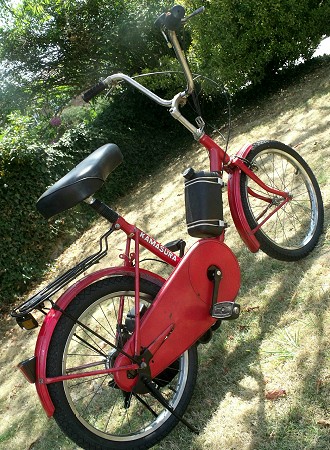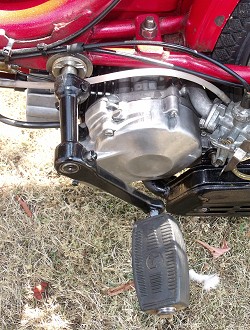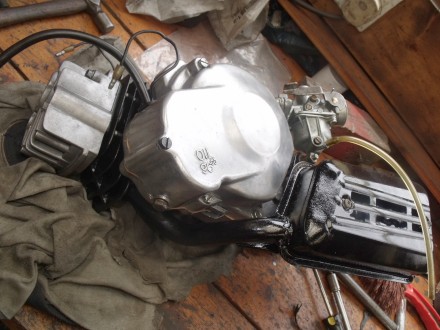This story starts on 12th November 1986, when the American magazine Cycle News first included a small item among its news columns: ‘Southern California based Continental Marketing U.S.A. is conducting market research for the new Made-in-Taiwan Kamasura VRX 250. According to Continental Marketing, the Kamasura is a 250cc single-cylinder street bike that will be available in spring 1987. Photos and specifications are not yet available but Continental Marketing say they are expecting material on the new bike in the future’.
Subsequent issues from Continental Marketing and Research Ltd reported the company was offering these motor cycles to consumers to judge the bikes’ performance and handling characteristics, and people could claim their Kamasura VRX 250 by ringing this number: (213) 452-2557.
Some 50,000 Continental Marketing and Research Ltd printed fliers were also sent out in a mass-mailing to promote the campaign which offered a ‘free motor cycle’ called the Kamasura VRX 250, for market research and evaluation, and the customer would only be required to pay between $298 to $348 in shipping costs from the Orient and US delivery fees according to where the customer lived, before receiving the merchandise. The offer was further validated by a mention of the Motorcycle Safety Foundation (MSF).
This would have seemed a relatively small sum for a new 250cc motor cycle … but you know what they say about offers that appear too good to be true…

Deliveries of the bikes started appearing in March and April of 1987, but customers didn’t seem to be receiving quite what they were expecting…
One period report said that: ‘Once the Kamasura arrives, it is found to be “a Taiwanese girl’s bicycle" with a 34.5cc two-stroke engine transmitting its power through a centrifugal clutch and plastic roller rubbing against the 20-inch rear tire”.
Cycle News magazine quickly reported that people were not receiving the expected 250cc motor cycle, and said ‘So, yes, there is a Kamasura; and, no, it isn’t a 250. Aside from its representation as a two-stroke with two wheels, nearly everything people are led to believe about it is false. It comes in pieces not pre-assembled; instead of oil injection, there’s a two-litre tank for pre-mix. No lights, no signals, no speedo. No great chances to evaluate the handling and performance of a hot 250 to be had here. Just a box, and inside, strapped to a bicycle from Taiwan, a sad and tiny engine’. The Motorcycle Safety Foundation (MSF) publicly demanded that Continental Marketing and Research cease using its name, as it was not associated with the company in any way, and most certainly did not endorse any of its promotions.
Over the 30 years subsequent to its brief appearance, the Kamasura has become something of a mysterious enigma in the moped world. There is so little information regarding the make, that even its dubious origins are shrouded in a fog of confusion, and the bike itself has become variously attributed as being a product of Japan, Taiwan, China, and even South Korea. There’s a lot of conflicting information published about the VRX 250, which often seems to have become confused with another Kamasura Emei 500 model, so we’re intent on trying to record all details correctly to establish a more accurate assessment and record.
Remarkably and inexplicably, a stray Kamasura VRX 250 has found its way across the Atlantic to Britain, which gives us a fantastic opportunity to assess it for ourselves… if only the workshops can make the decrepit old derelict function … and, following far more effort than the machine was actually worth, this is what we got…
It’s certainly a small step-through bicycle in a western sense (just 56 inches end-to-end, with a 31-inch wheelbase, and fixed 40-inch handlebar height), but the bike is not so different from many period bicycles ridden around far-eastern city streets and suburbs. This is not so surprising, considering that particularly the women of many oriental races are quite petite, but it might also seem unsurprising that the diminutive attributes of this cycle might not exactly suit the physical proportions of any typical American male who might be interested in owning a 250cc motor cycle.

A couple of aspects of the Kamasura lead to the conclusion it probably pre-existed as a bicycle that was chosen and adapted to take the cyclemotor engine.
The rear stays to the saddle stem carry a pre-fitted mounting for a typical cycle calliper brake, which is not used on the VRX because, instead, it has an 80mm band brake on the left side of the rear wheel, the brake casing marked ‘Silent Super 80 Primary Brake’
There is an engine mounting plate welded across the tubes behind the bottom bracket to convert the frame for cyclemotor installation. This bracket was clearly welded into place before the frame was painted (red metallic), making the frame a purpose conversion.
The standard bicycle left hand pedal crank has effectively been increased by the fitment of a 3-inch extension shaft, so the left hand pedal crank arm can clear the addition of the engine.
Transfers on the frame indicate the brand as Kamasura, and a further transfer on the steering headstock indicates the model as VRX 250. The rear wheel freewheel is marked ‘Rocket Brand, Taoyuan Bicycle Ind. Corp’ (a Taiwanese company), and the rear carrier is marked ‘LC Taiwan’. The original 20×2.125 tyres were not marked with any brand or country of origin.
The engine carries no external identification, but when the workshops had to dismantle much of it to increase its prospect of running, inside they found a number of primary components marked LESA, which we presume to have been a Taiwanese manufacturer of the motor. There seems a fairly large exhaust port considering the capacity of the engine, so we don’t expect four-stroke running to be an issue but, when turning the engine over, we note the bottom of the piston skirt actually clears the bottom of the exhaust port at TDC, exposing the inner crankcase! That’s certainly pretty bad engineering practice, and not anything we’d have expected a Japanese manufacturer to do.

The engine seems to measure 36mm bore × 33mm stroke, for 34cc in a cast iron cylinder with alloy head. It has an overhung crank with acres of space in the crankcase beneath the piston, so the efficiency of undercase compression scavenging through the three transfer ports was obviously not a consideration in the design. Induction is direct into the crankcase by reed-valve from an 11mm KeiHin (Japanese) carburettor. Removing the primary cover reveals a contactless CDI HT inside the oil-bath case, with a centrifugal clutch and, behind that, a pressed-steel epicyclic reduction gear drive to the output shaft with its rubber drive roller outside to the rear tyre.
The engine is controlled from the right-hand bar by a cheap and nasty combination throttle control & drive engagement mechanism, which is so badly riveted together that it’s still loose! The orange thumb-trigger requires quite a lot of pressure to operate against a strong spring at the other end of the cable to disengage the drive roller from the tyre. Once the orange trigger has travelled far enough, it latches off the drive, then unlatches again when you thumb the yellow trigger beneath the bar, which operates the throttle. (The yellow trigger would only open the carburettor slide to half-throttle, and the workshops had to make extensive repairs and modifications to this control mechanism to enable full throttle opening, since we really wanted to test our VRX to its maximum performance.)

The blow-moulded plastic 2-litre VRX fuel tank is held on to its mounts by two leather buckle straps, and mysteriously has no fuel tap! It didn’t come with a fuel tap originally, and there was no capability to fit a fuel tap into the original tank. This presents a fair difficulty in not being able to close off the fuel, which will steadily leach through the float valve in the carburettor, until it floods out of the float chamber, and all the contents of the tank end up in a puddle on the floor.
An easy and practical solution to this problem is to fit an in-line fuel tap—it’s a pity that the Kamasura’s makers couldn’t think of that. Consequently, fill the tank with the amount of fuel you think you’ll need for your journey, otherwise you might need to drain out whatever’s left inside, or put a drip tray underneath to collect the overflow.
We try with the choke on for starting, latch the lever on the carb up to strangle the shutter. Pedal away and build a bit of speed up before releasing the engine latch by thumbing the throttle trigger, then keep pedalling. The Kamasura proves a difficult machine to pedal because of the different width pedal offsets and the cramped physical size of the bike … and it doesn’t start. We try a couple more times, and it still doesn’t start, then try again with the choke off—and it starts almost straight away!
It’s fair to describe the starting impression as unspectacular, as we trickle along at a crawl pace, then lightly thumb the throttle lever to get some kind of feel of how the motor responds.
After having ridden so many direct-drive roller-drive cyclemotors, there seems something rather unnatural about riding a roller-drive cyclemotor with an automatic clutch! It just feels so odd when you stop and the engine is ticking over. Then open the throttle and the centrifugal clutch feeds in the drive like a moped would. It just doesn’t feel ‘normal’, and there are moments when you wonder if the drive isn’t engaged properly and the rubber-coated roller might be slipping as revs from the motor and noise from the exhaust almost seem to increase disproportionately to the road speed.

Tentatively teasing the throttle trigger, we coast the bike up and down the road a couple of times to try and get some feel of how the auto-clutch feeds in the take-off, but mainly to satisfy ourselves that the drive roller really isn’t slipping. Once the clutch has engaged, the engine revs seem to rise fairly quickly in response to the throttle trigger, but the road speed seems to rise less in proportion, so we conclude the gearing ratio is very low. As the revs pick up, the volume of angry noise from the obviously ineffective silencer quickly becomes far more offensive than any speed you might achieve.
The ‘muffler’ note sounds rather like a chainsaw with a broken exhaust. As you open the throttle, it becomes markedly intrusive, and riding along the road, you can tell that people hear it coming well before they can figure where the source of the racket is coming from. The level of noise produced also appears very disproportionate to the speed the Kamasura actually travels at, so riding the VRX isn’t going to do much for your street-cred!
Despite the workshops having adjusted the rear ‘Silent Super 80 Primary Brake’ to its optimum setting, and considering the low performance of the bike, the brake operation still proves remarkably ineffective—these band brakes are always pretty useless; they look like a good idea, but pull them on as hard as you can, and they still don’t work. Even the original bicycle calliper front brake proves more effective.
The Kamasura riding position is not comfortable, because the cycle feels too small and cramped for a western rider, and control of the machine consequently becomes an issue. Despite the low performance, handling can be very unsure and, other than the pneumatic effect of the tyres, there’s no suspension when you hit any bumps.
The CDI set has no lighting generator capabilities, so there are no lights (just a reflector on the rear mudguard), no fitted horn, and no speedometer, so we rely on our pacer again to take the speed readings. Along the flat in still air the bike runs angrily along on full throttle around 15–16mph and, during a light downhill run in a crouch our pacer reported we momentarily touched 20, producing a ‘most offensive’ din, and trailing a haze of blue smoke in out wake.
We've seen some reports that the Kamasura VRX 250 could achieve 45km/h! Nearly 30mph? No it absolutely won’t! This machine was carefully set up by the workshops to give everything it had, and the furious snarling revs at 20mph were definitely not anything that could be exceeded without taking the engine home in a bag!

So would anyone have chosen to buy one if they’d known what they were going to be getting?
No they wouldn’t, it’s complete rubbish!
Several months later, around August 1987, another company presenting itself as National Marketing and Research, offered a ‘free’ Yamoto Super 250GT street legal and motocross motor cycle for consumers to judge the bike’s performance and handling characteristics in use. This time the ‘opportunity’ was promoted by sending out direct-mail form letters which the customer had to claim within 48 hours by calling (213) 452-2557 (same number as the Kamasura), for just covering the shipping cost of $394.
A Cycle News reporter rang the company and received ‘vague’ replies to his enquiry, telling him it was ‘100 per cent street-legal, and a mid-sized bike equivalent to a 125 that you could take out and motocross with’. When asked if it had a 125cc engine, he replied ‘Yeah, close to that’.
Cycle News recommended that anyone considering this offer should ‘buyer beware’.
A Los Angeles newspaper note reported that when Inspector Tom Dugan, at the Los Angeles Division of the US Postal Inspector’s Office, was asked about the mailshot the US Postal Service was delivering, he ‘Suspected that the Yamoto, if there is such a thing, is probably going to be identical to the Kamasura’.
Mailing of the NMR Yamoto promotion was subsequently stopped, which effectively closed down this avenue, so relatively few Yamoto offers were probably taken-up, and there seems no reference to even what vehicles may have been received.
A further company calling itself Global Marketing and Testing Services (and again sharing the same phone number with the originally mentioned Continental Marketing and Research) then promoted a ‘free’ Emei 500 Motorcycle. In these offers, if the customer paid the shipping costs of $400, they received an abysmal Kamasura-branded moped, fitted with a poor quality clone-copy of a 47cc Sachs engine. Its model designation again seemed to misleadingly refer to the more ‘substantial body style’, rather than the actual displacement of the engine. The Kamasura Emei 500 proved to be a Chinese-manufactured product which, according to a data plate located on the underside of the seat, translated as ‘state-run Emei tool factory’.
There seem few actual reports of how customers reacted to their Kamasura mopeds, but it seems unlikely they would ever have got much use out of either the VRX 250, or the Emei 500, because both machines were hopelessly ineffectual.
With media communications more readily exposing these scams, the warnings probably blunted the effectiveness of such promotions before they developed to a full-blown national legal backlash.
Victims seemingly made little effort to return the Kamasura cyclemotors or mopeds, seek a refund, or pursue compensation through the courts, and there appear to be no records of any lawsuits related to any of the three ‘ghost’ companies, which presumably vanished into the night before the lawyers got to them.



